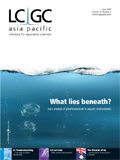TLC Product Showcase
TLC Product Showcase
Pre-scraped rotors
Available from Analtech are pre-scraped rotors that are sandwiched between specially molded plastic trays. These rotors can be taken directly from the packaging to the company's CycloGraph or Chromatotron system and be used immediately. All sizes from 1 mm to 8 mm are available. Additionally, the packaging can be used as a storage rack.

Analtech Inc., Newark, Delaware, USA.
TLC brochure and plates
Merck offers a brochure covering its complete range of thin layer chromatography (TLC) products. Product families consist of a broad range of conventional silica TLC plates, high performance silica plates (HPTLC) and a wide choice of RP-modified and cellulose plates. Additionally, various special products are included in the brochure such as concentrating zone plates and the company's UTLC and LiChrospher. In addition to this brochure offer, the company has released two types of HPTLC plates. The ProteoChrom silica and the ProteoChrom cellulose are both suitable for peptide analysis. The 20 × 20 cm PoteoChrom silica plates use an extra thin 100 μm silica layer that is suitable for one-dimensional separations. Whereas the 10 × 10 cm ProteoChrom cellulose sheets are optimal for two-dimensional separations. Both of these plates include special developed user protocols that cover all steps from plate development to detection with recommendations on solvent systems and staining.

Merck KgaA, Darmstadt, Germany.

Bibliography service for TLC
Camag has released a bibliography service that includes more than 100 abstracts of recent publications, demonstrating the flexibility of thin-layer chromatography (TLC). The CBS 98 emphasises planar chromatography as an essential component of modern analysis, for example, a method for the identification of unknown toxins in water using high performance (HP)TLC–MS coupling is featured. This bibliography is free-of-charge and an updated cumulative version can be downloaded from the company's website. Additionally, Camag Laboratory, the centre for applied HPTLC now has its own website: www.camag-laboratory.com. Results of basic and applied research projects are available through the website and a portfolio of services has been established to share knowledge with customers.

CAMAG, Muttenz, Switzerland.

TLC plates with a highly reflective surface
Available from Thomas Scientific are Whatman Diamond TLC plates that feature a highly reflective surface to minimize background noise while scanning for maximum range in detection. These plates feature an organic binder for the prevention of surface deterioration and are claimed to reduce band spreading because of uniform particle size and distribution. Additionally, the silica gel plates are available with channelling and linear preadsorbent spotting area and they have UV-254 fluorescent indicator.

Thomas Scientific, Swedesboro, New Jersey, USA.
Hard-layer TLC plate
Macherey-Nagel has introduced a hard layer thin-layer chromatography (TLC)-plate with unmodified silica. Adamant plates feature an organic binder system that results in a hard silica layer. It is claimed that as a result of the high abrasion resistance, the formation of dust on the surface of these plates is minimized. Although the abrasion resistance prevents undesired changes or damage to the layer (thickness) during transportation and/or handling the plates can be easily marked with a pencil for identification. A dust-free plate allows convenient handling and avoids silica contamination of the TLC developing chamber. Reportedly, the UV indicator of these TLC plates features an increased brilliance that, in combination with the low-noise background, results in an increased detection sensitivity.

Macherey-Nagel GmbH & Co. KG, Düren, Germany.

Determining Enhanced Sensitivity to Odors due to Anxiety-Associated Chemosignals with GC
May 8th 2025Based on their hypothesis that smelling anxiety chemosignals can, like visual anxiety induction, lead to an increase in odor sensitivity, a joint study between the University of Erlangen-Nuremberg (Erlangen, Germany) and the Fraunhofer Institute for Process Engineering and Packaging (Freising, Germany) combined behavioral experiments, odor profile analysis by a trained panel, and instrumental analysis of odorants (gas chromatography-olfactometry) and volatiles (gas chromatography-mass spectrometry).
Investigating 3D-Printable Stationary Phases in Liquid Chromatography
May 7th 20253D printing technology has potential in chromatography, but a major challenge is developing materials with both high porosity and robust mechanical properties. Recently, scientists compared the separation performances of eight different 3D printable stationary phases.
Detecting Hyper-Fast Chromatographic Peaks Using Ion Mobility Spectrometry
May 6th 2025Ion mobility spectrometers can detect trace compounds quickly, though they can face various issues with detecting certain peaks. University of Hannover scientists created a new system for resolving hyper-fast gas chromatography (GC) peaks.

.png&w=3840&q=75)

.png&w=3840&q=75)



.png&w=3840&q=75)



.png&w=3840&q=75)

















